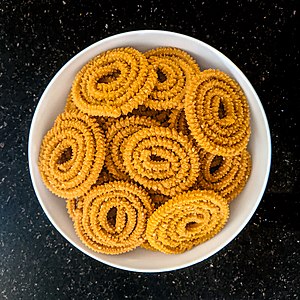Chakli
 Chakli | |
| Alternative names | Chakali, Chakli, Chakkuli, Chakri |
|---|---|
| Type | Fried dough |
| Course | Snack |
| Place of origin | Erstwhile Karnataka i.e Deccan Plateau now includes Maharashtra and Gujarat, India |
| Main ingredients | Rice flour, bengal gram flour, black gram flour, water, salt |
| Variations | Murukku -loaned to Tamil. Muruku means a piece in Kannada - chakli muruku means chakli piece. |

Chakli is a savoury snack from India. It is a spiral-shaped snack with a spiked surface.[1]
Chakli is typically made from flours of rice, Bengal gram (brown chickpea) and black gram (urad daal). It has several variations, depending on the types and proportion of flours used. Murukku, a similar snack typically made without Bengal gram flour, is also sometimes called "chakli". Chakri is also a common nickname for "Chakradhar," a name of Indian origin. It's especially made for Diwali. It's also very popular in South Africa, introduced by the Indian diaspora. Maize flour is used instead of rice flour with the addition of salt and cumin as the basic dry ingredients. It is sold by street vendors and at neighborhood shops.
Names
[edit]Other names of the dish include Kannada: ಚಕ್ಕುಲಿ chakkuli, Marathi: चकली chakali, Odiya: ଦାନ୍ତକଲି Dantkali, Gujarati: ચકરી chakri, Telugu: చక్రాలు chakralu or jantikalu and Konkani: Chakri or Chakkuli.
Murukku, a similar dish typically made without Bengal gram, is also sometimes called "chakli". Kadboli is a similar dish, which is shaped by hand instead of with an extruder. [2] In Indonesia, murukku and chakli variations are known as akar kelapa, and are particularly popular among Betawi.[3]
History
[edit]The earliest mention of a dish similar to Chakli comes from ancient Ayurvedic texts where it is known as "Saskuli"; it was made from spiced rice flour dough with sesame seeds and then placed in a presser to form a long thread-like design and fried in ghee or oil. [4][5] The word Saskuli literally translates to "ear-shaped" design.[6][7] This early variation of rice flour-based chakli may have more closely resembled rice-murukku than the chakli known today.[8] The recipe that closely resembles modern Chakli finds mention in the medieval period cookbook Soopa Shastra dated to 1509 AD. This recipe was made from a blend of rice flour, Bengal gram flour and urad dal flour.[9]
Ingredients and preparation
[edit]Chakli is made from the flours of rice, Bengal gram (chickpea) and black gram (urad dal). Other ingredients include coriander seed powder, cumin seed (jeera) powder, sesame seeds, red pepper powder, turmeric powder, salt, asafoetida powder and oil.[2] Some variations also include green gram (moong) and pigeon pea (tuar/arhar) instead of black gram.[10]
The flours and seed powders are mixed, and boiling water is added to make a dough. The dough is kneaded and shaped into circular forms, using a mould. In commercial food processing units, usually a chakli extruder is used for shaping the dough.[2] The shaped dough is fried in hot oil until it becomes brown in colour. It is then removed from the oil, drained and cooled.[2]
Gallery
[edit]-
Preparation of Chakri in hot oil
-
Frying chakli
-
Chaklis
-
Muruku Chaklis
-
Fully cooked chakli
-
Traditional brass presser used for chaklis and various other snacks.
See also
[edit]References
[edit]- ^ J. Smartt; Emmanuel Nwokolo (30 June 1996). Food and feed from legumes and oilseeds. Chapman & Hall. ISBN 978-0-412-45930-6.
- ^ a b c d Edmund W. Lusas; Lloyd W. Rooney (5 June 2001). Snack Foods Processing. CRC Press. pp. 488–. ISBN 978-1-4200-1254-5.
- ^ "Kue Akar Kelapa Makanan Khas Lebaran Warga Bekasi | Poskotanews.com". Archived from the original on 2012-04-30. Retrieved 2011-12-18.
- ^ Traditional Foods: Some Products and Technologies - Page 51- Central Food Technological Research Institute (India) · 1986
- ^ Traditional methods of food habits and dietary preparations in Ayurveda—the Indian system of medicine https://journalofethnicfoods.biomedcentral.com/articles/10.1186/s42779-019-0016-4 - Dhanya S (2019) Journal of Ethnic Foods volume 6, Article number: 14 (2019)
- ^ Srimad-Bhagavatam, Eleventh Canto: General History Disciples of His Divine Grace A. C. Bhaktivedanta Swami Prabhupada, 1982.
- ^ Feasts and Fasts: A History of Food in India, page 65, Colleen Taylor Sen · 2015
- ^ Spices in Indian Life, 6500 B.C.-1950 A.D. A Comprehensive and Critical Narration about the Role of Spices in Indian Life By Som Nath Mahindru, page 57, 1982.
- ^ The sweet flavour of tradition: mithai, chakli and other tastes of Diwali- Sulekha Nair- October 21, 2014-https://www.firstpost.com/politics/sweet-flavour-tradition-mithai-chakli-tastes-diwali-1766589.html
- ^ Neera Verma. South Indian Cook Book. Diamond Pocket Books (P) Ltd. pp. 46–. ISBN 978-81-7182-836-4.
External links
[edit]
| |
| See also | |
Text is available under the CC BY-SA 4.0 license; additional terms may apply.
Images, videos and audio are available under their respective licenses.









